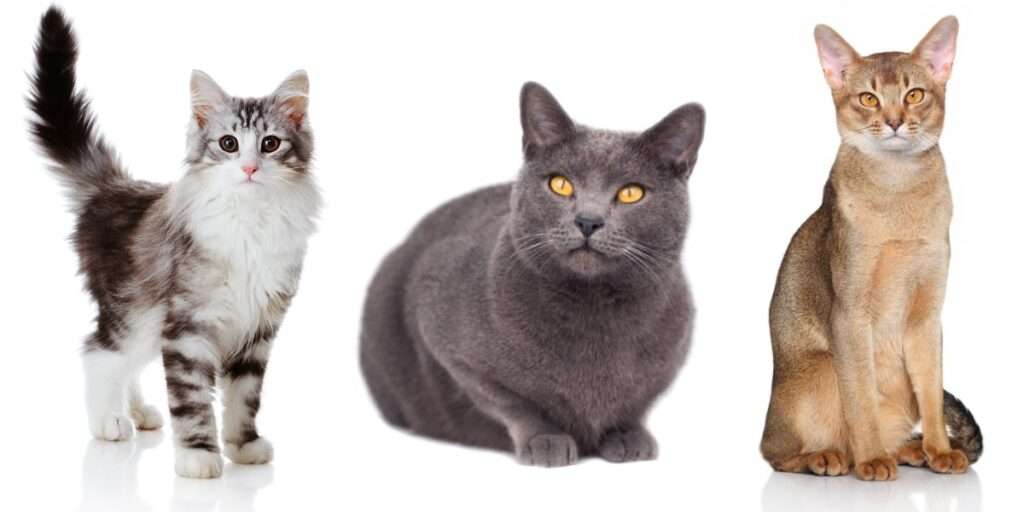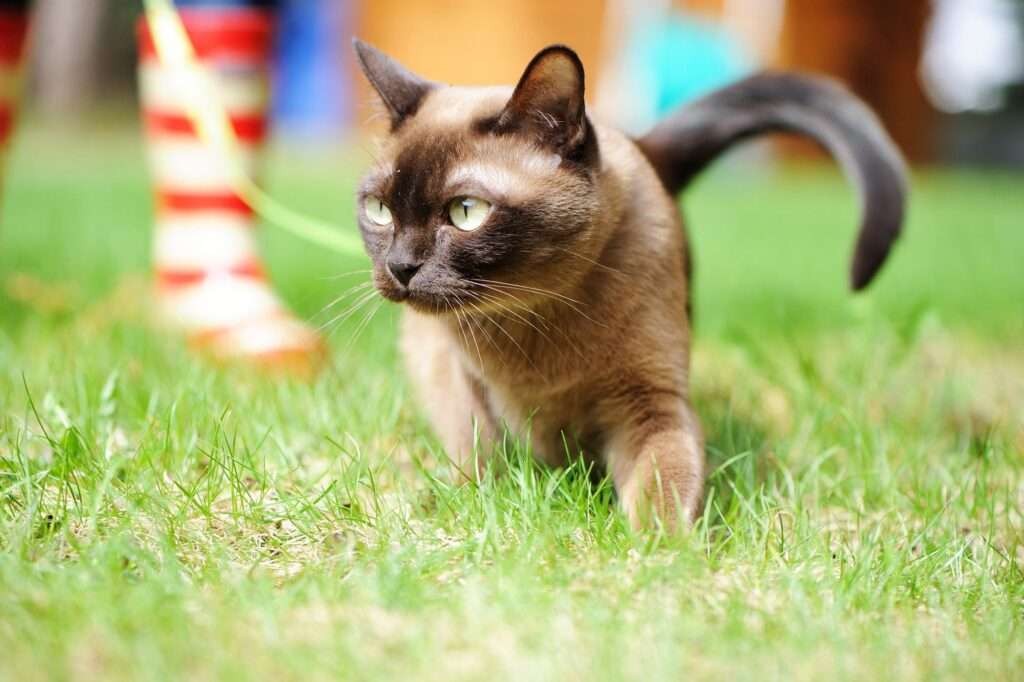
Ears Variations
Cats’ ears are usually erect and somewhat pointed. The structure and shape of feline ears are affected by a number of known mutations:
1) Folded ears
This characteristic is linked with a dominant mutation in the Fd gene that occurs spontaneously. This mutation solely affects the Scottish Fold breed. They have varying degrees of forward and downward folding on their ears. On the other hand, cartilage abnormalities like enlarged feet and thicker tails are also linked to this gene. Osteochondrodysplasia is the result of a deleterious mutation that occurs in cats who are homozygous. Consequently, to avoid homozygous fold progeny, breeders only cross folds with non-folds.

2) Curled ears
This distinctive trait is linked with the Cu gene, which is tied to the American Curl breed. Thankfully, this gene does not currently appear to cause any serious abnormalities.

3) Rounded ears
Initially, an Italy cat and a few stray Texas cats were seen to have rounded ears. The form of these ears is rounded as opposed to pointed. The trait’s carriers in Texas indeed went extinct, but the Italian variant is being evaluated for potential breed.

Tails Genetic Variations
1) Japanese Bobtail
The autosomal dominant mutation in the Japanese Bobtail gene (Jb) is linked to the breed’s distinctive characteristic of having a bobbed tail. Because of the dominant nature of the mutation, the tails of both homozygotes and heterozygotes will bob. The mutation that causes bobbed tails is benign and unrelated to skeletal problems or lethality, in contrast to other unusual tail morphologies.

2) Manx tailless
This trait results from a deleterious mutation that is dominant in the gene of Manx tailless, M. Homozygous carrier die before giving birth, whereas carriers that are heterozygous either have tailless tails or very stumpy, short tails. Occasionally, Manx cats may also display abnormalities related to their skeleton and organs, and some of them pass away before they reach 12 months old.

3) Short tails
It can be very challenging to differentiate “short” tails from Manx or bobbed tails. Shorter tails can be found in a wide variety of purebred or mixed breeds, and the majority of the genetic abnormalities that generate them are still being studied.

4) Curly tails
There are various kinds and mutations that can result in tails looping over from the rear. The new experimental breed known as American Ringtail is the result of one such mutation. Solomon, a 1998 Californian cat, served as the breed’s prototype. It appears that the mutation found in this cat is unrelated to any health problems. Ragdolls and American Shorthairs were crossed with curly-tailed cats.

Paws Variations
1) Syndactylism
The Split Foot gene (Sh) has been linked to this trait. The dominant mutation in the gene causes a cat to appear “lobster-claw” because it has less toes than normal cats.

2) Polydactylism
This characteristic—having more toes than usual—is linked to many dominant and recessive genes.

Genetic Variations in Size and Height
1) Munchkin legs
This trait, shorter legs is caused by a Munchkin gene dominant mutation (Mk). The kittens in the litter are very small, hence homozygous carriers may have a higher mortality rate. Still, despite having very short legs, Munchkin cats are not crippled, and the mutation does not seem to cause limited movement or spinal problems. Hypochondroplasia or pseudochondroplasia, which mainly affects the long bones of the legs while maintaining the rest of the body’s proportions, may be the anomaly instead of achondroplasia.

2) Teacup-sized Persians
Due to a dominant germ-cell mutation that was initially discovered in a male Persian cat by the name of Treker in 1995, these cats are extremely tiny, diminutive, yet proportionate Persian cats. Not all Persians today are descended from Treker; Teacup Persians are a distinct breed. In recent years, Silver and Golden colour divisions produced the majority of these kittens that were grown.

Cat coat genetics: Summary of main genes
- The feline the primary gene for coat colour (B/b/b1) produces coat colors like brown, chocolate, cinnamon, and other similar hues. The pigment eumelanin is encoded by this gene. Recessive allele B is associated with chocolate, dominant allele B1 with black, and all three with cinnamon. The other genes that contribute to the final feline phenotype determine the hue and pattern of these colors.

- The co-dominant red gene on the X chromosome (O/o), controls whether red variations in fur colour occur or not. This gene encodes phaeomelanin. The recessive allele O encodes non-orange pigmentation (black or brown), whereas the dominant gene O encodes orange tones. Because they only have one copy of the X chromosome, males can only carry one allele of this gene, either O or o. If they carry the allele O, they will be red, orange, or creamy; if not, they will have no orange tones in their fur.
- Females will have two distinct gene alleles because they have two X chromosomes. Heterozygotes (Oo) will be tortoiseshell, dominant homozygotes (OO) will have red tones, and recessive homozygotes (oo) will not have any orange tones. This explains the scarcity of male tortoiseshell cats.

- The presence or absence of white in the coat is determined by the KIT gene. Recessive (w) in nature, the wild-type allele of this gene prevents homozygotes from having any white in their coat. White spotting (WS), dominant white (WD), and the recessive Birman white gloving allele (wg) are the other KIT alleles.

- Complete white coloration is encoded by the dominant white gene (WD), which prevents melanocyte migration and replication into the skin. It is also connected to deafness and blue eyes. Since the characteristic is inherited dominantly, expression of the trait requires only one variant.
- Although it only prevents melanocytes from migrating to certain skin patches, the dominant white spotting gene (WS) causes the development of white spots or areas.
- Lastly, the condition is caused by the recessive Birman gloving allele (wg), which requires two alleles to manifest and results in the Birman-specific white gloves.
Genetics Cat coat
Tuxedo, Van or Bicolor
In this type of the coat, the cat has white patches mixed in with its primary (non-white) colour. The pattern varies from Van, which is primarily white with a colored tail and top of the head, to Tuxedo, which is black with a small amount of white on the chest. Tortoiseshell, crimson, or black can be the base colour. The white patches or spots in the fur are caused by the white spotting gene (WS). Regarding this particular mutation, the heterozygotes display less extensive white patching compared to the dominant homozygote (WSWS).

Tabby
The marbled pattern of tabby divas includes swirling patterns, stripes, dots, bullseyes, and butterflies. An “M” shape is also frequently drawn on their forehead. A tabby’s hair has distinct colour bands that may be seen when examining a single hair in further detail. The agouti gene’s dominant allele (A) is responsible for this pattern. The agouti gene permits complete pigmentation during the initial stages of hair growth, after which it slows down and then accelerates pigment synthesis once more. Along the hair, this produces the colored bands. Both phaeomelanistic (red-based) and eumelanistic (black-based) coats exhibit the agouti banding.

This gene’s recessive allele is known as non-agouti. Solid coloration is only seen in recessive homozygotes (a/a) for this gene. On the other hand, the tabby gene controls the coat’s tabby pattern. These banded hairs will alternate between solid patches, stripes, and spots due to this gene. There are four recognized tabby patterns: spotted, classic, ticking, and mackerel. Additionally, tabbies can be seen in various basic coat patterns like tortoiseshell or calico.
The four tabby patterns:
- Vertical stripes on the sides define mackerel tabbies, also referred to as “fishbone tabbies”. On the stomach and flanks, the thin lines may be continuous or divided into bars and patches. This is the most typical pattern among tabby cats.
- Swirled designs adorn the sides of classic tabbies, which are frequently referred to as “blotched” or “marbled”. There are three small stripes down the spine and a light “butterfly” pattern on the shoulders.
- The ticked tabbies has no stripes. Their appearance resemble sand and have colorful bands.
- The stripes of spotted tabbies are divided into larger and smaller spots. Serengeti, Bengal, Egyptian Mau, Maine Coon, Arabian Mau, and other breeds frequently exhibit this pattern.




